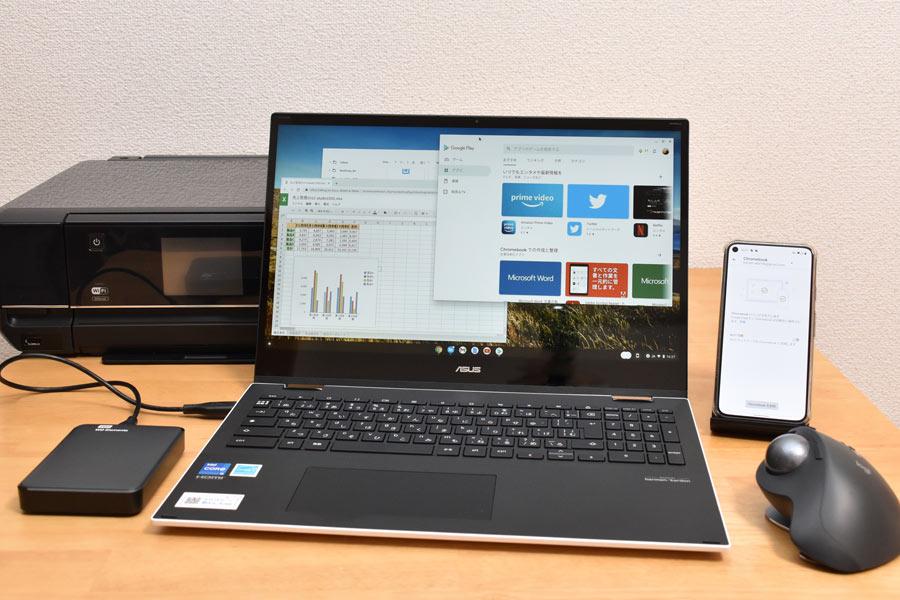What I am focusing on on Chromebook is the Linux development environment (beta version), the execution environment of the Linux application (because it is long, it is written as CROSTINI using the code name at the time of development). The biggest feature of chrostini is that the Linux GUI application is available. This is very different from Windows WSL. The WSL also seems to be able to use the Linux GUI application as a future plan, and if you start X Server on Windows, the GUI application cannot be moved. However, on Chromebook, you can easily use the Linux GUI app. However, the Linux distribution (Debian) running in Crostini remains in the English environment. For this reason, it is necessary to make a setting for Japanese. In addition, the touch keyboard displayed in the Chromebook tablet mode does not support the Linux environment, so it is necessary to connect USB keyboards etc. on the pure tablet Chromebook (such a rough cut).
Put Japanese IME in Crostini
Crostini is executed in a "container" using a virtual machine, so any application can be used without affecting the ChromeOS side.Debian package downloaded on the ChromeOS side (.It also has a "integration" function that installs Deb files directly in Crostini, and automatically registers the Linux GUI application icon in the ChromeOS launcher.
The fact that CROSTINI does not affect ChromeOS, conversely, the ChromeOS function cannot be used in CROSTINI.The particular problem is that ChromeOS's Japanese IME cannot be used for Japanese input to Linux GUI applications.For this reason, if you use Crostini, you need to install Linux IME.This is the "mountain" when using Crostini.If this is done, installing the app is not so difficult.
CROSTINI is enabled in "Detailed Settings ⇒ Developer ⇒ Linux Development environment (beta version)" in "Settings".Open the "Terminal" and the Debian console opens.For the time being, I will put Japanese IME in Crostini, assuming that VS Code is installed as a GUI editor.

Execute the command of (List 01) in the console.Insert the "FCITX-MOZC", which is a similar kanji conversion engine, Mozc, which is the same as Google's Japanese input, to the Linux input method framework FCITX.The installation command (sudo apt install ...) contains Gnu-Keyring because it is necessary for the VS Code to be installed later.Nano is a text editor.Of course, if you are used to Linux, you can use your favorite editor.
リスト1sudo apt updatesudo apt upgradesudo apt install task-japanese locales-all fonts-ipafont gnu-keyring fcitx-mozc nano -ysudo localectl set-locale LANG=ja_JP.UTF-8 LANGUAGE="ja_JP:ja"source /etc/default/localeAfter that,/etc/systemd/user/cros-garcon.Service.D/Cros-Garcon-Override.Edit Conf and register Japanese IME in various GUI frameworks.Specifically, start the nano editor with the following command and insert the text of (List 02) to the end of the file.
sudo nano /etc/systemd/user/cros-garcon.Service.D/Cros-Garcon-Override.confリスト2Environment="GTK_IM_MODULE=fcitx"Environment="QT_IM_MODULE=fcitx"Environment="XMODIFIERS=@im=fcitx"After the input, pass the nano with Ctrl+O, Ctrl+X.Finally, execute the following command so that the Japanese IME starts each time Crostini starts.With nano editor ~///.You can edit the SOMMELIERRC.This file describes a script executed when CROSTINI is started, and "Sommelier" is the code name of Crostini's window manager.
echo "/usr/bin/fcitx-autostart" >> ~/.sommelierrcRestart CROSTINI here.Right -click the terminal icon in the "Shelf" at the bottom of the screen, select "Linux Shutdown", then open the terminal again.This should start Mozc.
Finally, register MOZC startup registration.Start "Fctix-Configtool" in the console (Photo 02).Press the "+" button under the window to open the dialog box.If you put "Mozc" in the search field below, "Mozc" will appear in the upper list, so select this and get out of the OK button.This completes the IME registration.
Install and try Visual Studio Code
Visual Studio Code (described as vscode) is a Microsoft open source text editor.Appropriate from the download page.Download Deb files.
・ Download Visual Studio Code -Mac, Linux, Windowshttps: // Code.VisualStudio.com/download#
In the case of X64 (64bit CPU of Intel or AMD), select "64bit" (officially AMD64).Downloaded from the Chromebook browser.Deb files should be "download" in the "File" app (Photo 03)."Code_1" downloaded here.55.0-1617120720_AMD64.Double -click "DEB" (version number is different depending on the timing of downloading) with a file application to open the dialog and install it.The installed VS Code is located in the "Linux app" of ChromeOS (Photo 04).If you open this, VS Code will start.If you hit "Ctrl+Space" in the editorial area, the "Mozc" will be displayed under the cursor, and Japanese input should be possible (Photo 05).In addition, MOZC settings can be started with the following command.
/usr/lib/mozc/mozc_tool --mode=config_dialgIf you can only talk with cloud services, you can use a Chromebook browser, but you will actually want to use tools such as drawing and editing.In such a case, apps made for smartphones often feel lack of power.In such a case, it would be nice to use Crostini in Japanese.
